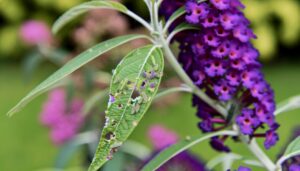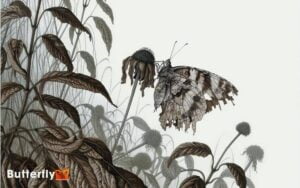How To Identify A Butterfly? A Comprehensive Guide!
To identify a butterfly, start by observing the wing shape notice if they’re broad or narrow, scalloped or smooth. Examine the wing patterns, paying attention to spot size, stripes, and unique markings.
Note the wing colors, including gradients, iridescence, and metallic sheens. Observe the body structure, such as thorax segmentation and leg proportions.
Check the antennae; they could be clubbed or feathery. Also, consider the butterfly’s habitat and geographic location. Watch their feeding habits and look for seasonal variations.
Utilize identification guides for visual markers and behavioral traits. Continue on to grasp deeper insights into these fascinating creatures.

Key Takeaways
Observe Wing Shape
To accurately identify a butterfly, start by closely examining the shape of its wings. Notice whether the wings are broad and rounded or narrow and elongated. Look for unique features such as scalloped edges or elongated tails known as ‘tails’ on swallowtails.
Measure the wingspan, noting if it’s vitally important or small relative to the body. Observe the wing venation the pattern of veins can offer critical clues. Are the veins prominent and highly branched, or simpler and fewer?
Also, check the forewings and hindwings for any noticeable structural differences.
These morphological characteristics are vital for distinguishing between species, as wing shape often aligns with specific evolutionary adaptations. Your keen observation will pave the way for accurate butterfly identification.
Examine Wing Patterns
Begin by scrutinizing the intricate patterns on the butterfly’s wings, noting the arrangement and coloration of spots, stripes, and other markings. Pay close attention to these features, as they can be essential for accurate identification.
Consider the following:
Spot Configuration:
- Observe the size, shape, and distribution of spots.
- Are they scattered or symmetrically arranged?
Stripe Orientation:
- Look at the direction and curvature of stripes.
- Do they run parallel or intersect?
Border Patterns:
- Examine the edges of the wings for distinct borders or fringes.
- Are there alternating colors or fine lines?
Unique Markings:
- Identify any unique or standout markings that can differentiate species.
Note Wing Colors
Carefully observe the primary and secondary colors on the butterfly’s wings, noting any gradients, iridescence, or color shifts that may occur.
Examine the hues with precision, identifying specific shades such as cerulean, vermilion, or chartreuse.
Pay attention to the spatial arrangement of these colors; some butterflies exhibit radial symmetry while others display bilateral symmetry.
Look for metallic sheens or color morphs that can change with the angle of light, a phenomenon known as structural coloration.
Document any unique combinations or patterns of colors, as these can be essential for accurate identification.
Use a magnifying glass if necessary to discern subtle variations and make sure your observations are methodical and thorough, capturing the butterfly’s full chromatic spectrum.
Look at Body Structure
Examine the butterfly’s body structure, focusing on the segmentation of the thorax and abdomen, and noting the proportions and articulation of the legs and antennae.
Start by observing the thorax, which houses the muscles for wing and leg movement. Notice how it connects to the abdomen, which is typically elongated and segmented.
- Pay attention to the legs, which are often slender and articulated at the joints.
- Additionally, the antennae should be noted for their position and movement.
- Your careful observation will aid in accurate identification.
Analyze Antenna Shape
The butterfly’s antennae, which are crucial for navigation and sensing the environment, exhibit a variety of shapes that can help distinguish different species. You should closely observe the antennae’s morphology.
Clubbed antennae are common in most butterflies, characterized by a thickening at the distal end. This structure aids in their chemosensory functions.
In contrast, moths often have feathery or filamentous antennae, which are more specialized for pheromone detection. Note the length and curvature; some species have uniquely elongated or bent antennae. Utilize a magnifying tool for precision.
Documenting these traits can lead to accurate species identification. By focusing on these minute details, you’ll contribute to a nuanced understanding of butterfly taxonomy and enhance your field expertise.
Study Flight Behavior
To study flight behavior, you’ll need to observe flight patterns meticulously, noting any unique trajectories or speeds. Pay close attention to wing movement, as the frequency and amplitude can help differentiate species.
Flight Patterns Observation
Carefully observe the butterfly’s flight patterns, noting any unique characteristics such as fluttering frequency and trajectory consistency. Pay attention to how they navigate their environment.
- Fluttering Frequency: Count the wing beats per second; some species have rapid, almost hummingbird-like movements.
- Trajectory Consistency: Analyze the straightness or randomness of their flight path; certain butterflies follow a predictable route.
- Altitude Variation: Note how high or low they fly; some prefer staying close to the ground, while others soar higher.
- Turning Ability: Observe their agility in making sharp turns or smooth arcs; this can be a key identifier.
Wing Movement Analysis
Examining wing movement involves scrutinizing the amplitude, frequency, and synchronization of the butterfly’s wing beats to distinguish between species.
You’ll need to measure the vertical displacement of the wings (amplitude) and count how many times the wings beat per second (frequency).
Note that some species exhibit precise wing synchronization, while others display asynchronous patterns. Employ high-speed cameras and motion capture software for accurate data collection.
Documenting these parameters allows you to create unique wing movement signatures that can be cross-referenced with known species. This methodical approach isn’t just about observation; it’s about quantifying behavior to foster innovation in species identification.
Check Habitat Type
When identifying a butterfly, you’ll need to observe the habitat in which you find it. Butterflies frequent various environments, including urban and rural areas, forest and woodland regions, as well as garden and park locations.
Each habitat supports different species, so noting the specific environment can greatly narrow down your identification.
Urban and Rural Areas
To identify a butterfly, you must first assess whether you’re in an urban or rural area, as habitat type greatly influences butterfly species distribution. In urban areas, look for species adapted to human-modified environments.
These butterflies often thrive in:
- Gardens: Species like the Monarch frequent urban gardens with milkweed.
- Parks: Look for Painted Ladies in city parks that provide nectar-rich flowers.
- Roadside Verges: Common Blues can be found in grassy roadside patches.
- Waste Grounds: Check for Cabbage Whites in vacant lots with wild plants.
In contrast, rural areas host more diverse species due to less habitat fragmentation. Here, butterflies such as the Swallowtail and the Brimstone might be found in open fields and meadows, indicating a richer ecological tapestry.
Forest and Woodland Regions
In forest and woodland regions, you should focus on identifying butterflies that are adapted to shaded and humid microclimates, such as the Speckled Wood and the Purple Emperor. Examine the canopy density and undergrowth. Additionally, pay attention to flowering plants and sap runs, as these can attract various butterfly species. Observing their behavior and flight patterns can also provide clues about their preferred habitats. Furthermore, identifying butterfly predators, such as birds and spiders, can help you understand the ecological balance within the woodland environment.
Speckled Woods thrive where light dapples through leaves, exhibiting territorial behavior in sunlit patches. Their wings display brown with creamy spots.
The Purple Emperor prefers oak woodlands; males are often seen high in the canopy, exhibiting iridescent blue-purple hues in sunlight. Check for their distinctive white-banded wings. Also, observe ground-level activity; females are more likely to descend.
Use a field guide for precise identification and document your observations with geo-tagged photos to contribute to citizen science databases, driving innovation in conservation efforts.
Garden and Park Locations
You’ll want to examine garden and park locations for butterflies that thrive in open, sunny areas with ample nectar sources, such as the Painted Lady and the Peacock.
Start by identifying key features of these environments:
- Floral Diversity: Rich variety of flowering plants guarantees a continuous nectar supply.
- Sun Exposure: Butterflies are ectothermic; they need sunlight to regulate their body temperature.
- Water Sources: Shallow puddles or moist soil provide essential hydration and minerals.
- Shelter: Dense shrubs or trees offer protection from predators and harsh weather.
In these habitats, you’ll often observe distinct behaviors such as basking, feeding, and mating. Documenting these actions helps in accurate identification.
Use a field guide or app to cross-reference observed species, ensuring precise identification amidst varying patterns and colors.
Consider Geographic Location
Understanding the geographic location where you spot a butterfly greatly narrows down the potential species you might be observing. Begin by identifying the region tropical, temperate, or arctic as each hosts distinct butterfly populations.
Utilize local field guides or databases to cross-reference your findings with documented species in that area. Pay attention to elevation; some butterflies thrive only at specific altitudes. Consider the season, as migratory patterns can influence which species are present.
Additionally, note nearby flora since butterflies often inhabit areas where their larval host plants are abundant.
By methodically analyzing these geographic factors, you’ll efficiently streamline your identification process, ensuring that you focus on the most likely candidates based on your precise location and environmental context.
Observe Feeding Habits
Observing a butterfly’s feeding habits provides essential insights into its species identification by examining its preferred nectar sources and feeding patterns. You’ll note that different species exhibit distinct preferences and behaviors.
Pay close attention to:
- Nectar Source: Identify the specific flowers or plants the butterfly frequents, such as milkweed, coneflowers, or lantana.
- Feeding Time: Document the time of day when the butterfly is most active; many species feed during mid-morning hours.
- Feeding Duration: Observe how long the butterfly spends on each flower; prolonged feeding can indicate the availability of high-energy nectar.
- Proboscis Use: Watch how the butterfly uses its proboscis to extract nectar, as the technique can vary between species.
Look for Seasonal Variations
Seasonal variations play a significant role in identifying butterflies, as many species exhibit changes in coloration, size, and behavior throughout the year.
During spring, you might notice brighter colors and increased activity as butterflies emerge from chrysalis. In contrast, autumn brings more subdued hues and preparatory behaviors for overwintering.
| Season | Coloration | Behavior |
|---|---|---|
| Spring | Bright, vivid hues | Emergence and mating |
| Summer | Consistent, vibrant | Territorial and feeding |
| Autumn | Subdued, earthy tones | Migration and dormancy |
| Winter | Rare sightings | Overwintering strategies |
Pay attention to these seasonal shifts to accurately identify species. Observing these patterns can enhance your understanding of butterfly ecology and contribute to innovative conservation efforts.
Use Identification Guides
To accurately identify butterfly species, it’s important to utilize detailed identification guides that provide extensive information on visual markers, habitat preferences, and behavioral traits.
These guides offer thorough details and high-resolution images, helping you differentiate between closely related species.
Here’s how to maximize their use:
- Visual Markers: Examine wing patterns, colors, and shapes to distinguish species.
- Habitat Preferences: Note the environments where different butterflies thrive, such as forests, meadows, or wetlands.
- Behavioral Traits: Observe flight patterns and feeding habits, which can be unique to specific species.
- Seasonal Variations: Understand how seasonal changes affect appearance and presence.
Conclusion
You’ve now got the tools to identify butterflies with precision and confidence.
Did you know that there are over 17,500 butterfly species worldwide? Imagine the vibrant kaleidoscope of colors and patterns fluttering through diverse habitats.
By observing wing shape, patterns, colors, body structure, antenna shape, and feeding habits, and considering geographic location and seasonal variations, you can accurately identify these enchanting creatures.
Use identification guides to refine your skills and become a butterfly expert.
Happy spotting!







Pretty! This has been an incredibly wonderful article.
Many thanks for supplying these details.
Here is my site nordvpn coupons inspiresensation (t.co)
I love your blog.. very nice colors & theme. Did you make this website yourself or did you
hire someone to do it for you? Plz respond as I’m looking to design my own blog and would like to find out where u got this from.
thanks a lot
my web site – nordvpn coupons inspiresensation
This is my first time go to see at here and i am really happy to read
all at alone place.
Here is my web page – nordvpn coupons inspiresensation
This website was… how do you say it? Relevant!! Finally I have found something that helped me.
Appreciate it!
My website nordvpn coupons inspiresensation